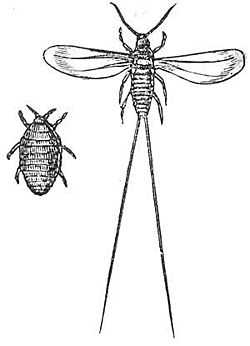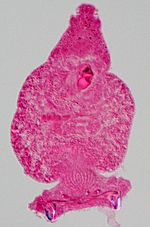Cochineal facts for kids
Quick facts for kids Cochineal |
|
|---|---|
 |
|
| Female (left) and male (right) cochineals | |
| Scientific classification | |
| Domain: | |
| Kingdom: | |
| Phylum: | |
| Class: | |
| Order: | |
| Superfamily: | |
| Family: |
Dactylopiidae
|
| Genus: |
Dactylopius
|
| Species: |
D. coccus
|
| Binomial name | |
| Dactylopius coccus Costa, 1835
|
|
| Synonyms | |
|
Coccus cacti Linnaeus, 1758 |
|
The cochineal (Dactylopius coccus) is a tiny scale insect. It is famous because a natural red dye called carmine is made from it.
These insects live in warm places like South America, Mexico, and Arizona. They eat cacti, especially a type called Opuntia. The cochineal insects get their food and water from the cactus pads. People collect them from the cacti and dry them to make the dye.
The red color comes from something called carminic acid, which is found in the insect's body and eggs. This acid makes up about 17-24% of the dried insect's weight. When mixed with certain salts, it creates the bright carmine dye. Today, carmine is mostly used to color food and lipstick.
In Central America, people used carmine dye for coloring fabrics as early as the 15th century. It became a very important product to sell during the time when European countries ruled parts of Latin America. Recently, people have become more worried about artificial food colors. This has made natural cochineal dyes popular again. Because of this, farming cochineal insects is now profitable, and Peru is the biggest exporter.
| Top - 0-9 A B C D E F G H I J K L M N O P Q R S T U V W X Y Z |
What is a Cochineal Insect?
Cochineal insects have soft bodies and are flat and oval-shaped. The females do not have wings and are about 5 millimeters (0.2 inches) long. They usually gather in groups on cactus pads. They use their special beak-like mouths to poke into the cactus and drink its juices. Once they start feeding, they usually stay in one spot unless something scares them.
The young cochineal insects, called nymphs, produce a waxy white substance. This wax covers their bodies and helps protect them from losing water and from too much sun. This is why cochineal insects often look white or gray from the outside. However, their bodies and the nymphs inside are dark purple because they produce the red pigment. Adult male cochineals are different from females. They are much smaller and have wings.
How Cochineals are Farmed
A farm where nopal cacti are grown to produce cochineal is traditionally called a nopalry. There are two main ways to farm cochineal: traditional and controlled.
In the traditional method, farmers plant cactus pads that already have cochineal insects on them. Or, they put cochineals onto existing cacti. Then, they collect the insects by hand.
The controlled method uses small baskets called Zapotec nests. These baskets are placed on the host cacti. The baskets contain clean, healthy female cochineals. These females leave the nests and settle on the cactus. In both farming methods, it is very important to protect the cochineals from animals that eat them, cold weather, and rain.
The whole process, from egg to adult, takes about three months. During this time, the cacti are kept at a steady temperature of about 27°C (81°F). At the end of the cycle, the new cochineals are either left to have more babies or they are collected. The collected insects are then dried to make the dye. To get the best dye, insects are usually collected when they are about 90 days old. Collecting the insects takes a lot of effort. Farmers must knock, brush, or pick each insect off the cacti by hand and put them into bags.
Cochineal Farming in Australia
Opuntia species, also known as prickly pears, were first brought to Australia in 1788. This was an attempt to start a cochineal dye industry there. Captain Arthur Phillip brought some cochineal-infested plants from Brazil. He was on his way to set up the first European settlement at Botany Bay, which is now part of Sydney, New South Wales.
At that time, Spain and Portugal had control over most of the world's cochineal dye trade. The British wanted their own source because the dye was very important for their clothing industry. For example, it was used to color the red coats of British soldiers.
However, this attempt did not work out well. The Brazilian cochineal insects soon died. But the cactus plants grew very well, too well! They ended up covering about 100,000 square miles (260,000 square kilometers) of eastern Australia. The cacti were finally brought under control in the 1920s. This happened when a South American moth, Cactoblastis cactorum, was purposely introduced. The larvae of this moth eat the cactus, which helped clear the land.
Making Cochineal Dye
The carminic acid is taken from the female cochineal insects. It is then processed to create carmine dye. This dye can make different shades of red, like crimson and scarlet.
To process the insects, they are put in hot water, or left in the sun, or exposed to steam, or heated in an oven. Each different method creates a slightly different color. It takes a lot of insects to make the dye. About 80,000 to 100,000 insects are needed to make just one kilogram (about 2.2 pounds) of cochineal dye.
What Cochineal Dye is Used For

In the past, cochineal was mainly used to color fabrics. During the time when Europeans ruled Latin America, more sheep were brought in. This meant more wool was available. The use of cochineal dye grew because it gave the most intense color and stayed on woolen clothes very well. Cochineal dye generally works better on animal fibers like wool and silk than on plant-based materials.
For many centuries, it was the most important insect dye used for making hand-woven oriental rugs. It was also used for painting, handicrafts, and tapestries. Cochineal-colored wool and cotton are still important materials for Mexican folk art and crafts.
Today, cochineal is used as a dye for fabrics and cosmetics. It is also a natural food coloring. Cochineal is special because it is one of the few water-soluble colors that does not fade much over time.
The form of cochineal that dissolves in water is used in alcoholic drinks. The form that does not dissolve in water is used in many other products. You can find it in meat, sausages, processed poultry products, and marinades. It is also in bakery items, cookies, desserts, jams, gelatin desserts, juices, some cheddar cheese and other dairy products, sauces, and sweets.
Carmine is considered safe enough to be used in eye makeup. A large amount of the carmine dye that does not dissolve in water is used in the cosmetics industry. It is found in products for hair and skin care, lipsticks, face powders, and blushes. The pharmaceutical industry also uses cochineal to color pills and ointments.
Images for kids
-
The chemical structure of carminic acid. This is the substance in cochineal insects that helps them avoid predators. The red and purple dyes called "carmine" are made from the insoluble salts of this acid.
-
Cochineal insects on cacti in La Palma, Canary Islands.
-
Wool that has been dyed with cochineal.
-
Steps in the cochineal harvest in Oaxaca, shown in a public mural by Arturo Garcia Bustos, Mexico.
-
Mexican Indian Collecting Cochineal with a Deer Tail by José Antonio de Alzate y Ramírez (1777). The host plant is a prickly pear cactus.
See also
 In Spanish: Cochinilla para niños
In Spanish: Cochinilla para niños












